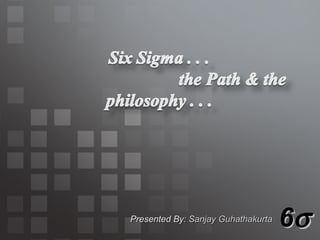
E Rev Max The Sigma Way
- 1. 6 Presented By: Sanjay Guhathakurta
- 6. As an example, we are developing Software. Two major defects typically related to these software are a) Server Connection failure b) Application Interface not Supported by HDD. Now let's say those defects are found only on 3 of products out of 6. Finally lets assume there are 3 steps in the developing process where those defects are typically introduced. Clearly, there are several opportunities for a defect to occur. To calculate how many, you simply multiply: 2 x 3 x 3, for a total of 18 opportunities. Now, if you find connection failure in 5 percent of the software that come off the develop line, the number of defects per opportunity is .00278 (.05 divided by 18). To find the number of defects per thousand opportunities, you multiply .00278 by 1,000 to get 2.78. Motorola engineers decided that the defects-per-thousand metric wasn't sensitive enough for their new Six Sigma initiative.They decided that defects per million opportunities (DPMO) eliminated errors due to small sample size and made for a more accurate determination of quality. To find the number of defects per million opportunities in our example above, we multiply .00278 by 1,000,000 to get 2,780 DPMO.
- 7. 6 Six Sigma is a highly disciplined process that helps us focus on developing & delivering near-perfect products and services. “ Sigma” is a statistical term that measures how far a given process deviates from perfection. What is Six Sigma? 1 12 2 3 4 5 6 7 8 9 10 11 1 1 1 1 1 1 6 LSL USL
- 8. s( ) 2 69.1% 3 93.32% 4 99.379% 5 99.9767% 6 99.99966% % Non-Defective 6 2 308,537 3 66,807 4 6,210 5 233 6 3.4 Sigma DPM A Measurement
- 9. 6 Practical Meaning 99% Good 99.99966% Good Postal System 20,000 Lost Articles Of Mail / Hr 7 Lost Articles / Hr Airline System Two Short/Long Landings / Day 1 Short / Long Per 5 Years Medical Profession 200,000 Wrong Drug Prescriptions / Year 68 Wrong Drug Prescriptions
- 10. Width of landing strip 1/2 Width of landing strip If pilot always lands within 1/2 the landing strip width, we say that he has Six-sigma capability. Pilot’s Six-Sigma Performance 6
- 11. Purpose of Six Sigma KANO Model of Customer Needs 6 So far customer satisfaction was mostly seen as a one-dimensional construction - the higher the perceived product quality, the higher the customer’s satisfaction and vice versa. The basic questions to face were, Which products and services can be used to obtain a high level of customer satisfaction? Which product features have a more than proportional influence on satisfaction, and which attributes are an absolute must in the eyes of th e customer? But fulfilling the individual product requirements to a great extent does not necessarily imply a high level of customer satisfaction. It is also the type of requirement which defines the perceived product quality and thus customer satisfaction. In his model, Prof. Kano (Kano, 1984) distinguishes between three types of product requirements which influence customer satisfaction in different ways when met :
- 12. 6 Must-be requirements/ Basic Attributes: If these requirements are not fulfilled, the customer will be extremely dissatisfied. On the other hand, as the customer takes these requirements for granted, their fulfillment will not increase his satisfaction. The must-be requirements are basic criteria of a product. Fulfilling the must-be requirements will only lead to a state of "not dissatisfied". The customer regards the must-be requirements as prerequisites, he takes them for granted and therefore does not explicitly demand them. Must-be requirements are in any case a decisive competitive factor, and if they are not fulfilled, the customer will not be interested in the product at all. One-dimensional requirements / Performance Attributes: With regard to these requirements, customer satisfaction is proportional to the level of fulfillment - the higher the level of fulfillment, the higher the customer’s satisfaction and vice versa. One-dimensional requirements are usually explicitly demanded by the customer.
- 13. 6 Attractive requirements/ Excitement Attributes: These requirements are the product criteria which have the greatest influence on how satisfied a customer will be with a given product. Attractive requirements are neither explicitly expressed nor expected by the customer. Fulfilling these requirements leads to more than proportional satisfaction. If they are not met, however, there is no feeling of dissatisfaction.
- 14. 6 Unspoken Spoken Performance Customer Disatisfaction Change Time Customer Satisfaction Excitement features: Initiate satisfaction if they are offered. They increase the noticed benefit of the core functionality Performance features: Attributes which lead as well to satisfaction as to dissatisfaction Basic features: Minimum features which represent the Core functionality of a product or a service Exceeds all Customer’s requirements + Better Communication with the customers + Understand customers and their needs + Ultimately Customer Satisfaction
- 19. 6 Some of the key Six Sigma Tools which could be used for the Six Sigma Analysis of eRevMax Process. Cause & Effects Matrix Fishbone Charts Basic Statistics Failure Modes & Effects Analysis (FMEA) Control Charts and Statistical Process Control (SPC) Measurement Systems Analysis Gage R&R Pareto Charts Sigma Capability Computations Multi-Vari Analysis Hypothesis Testing Design of Experiments Mistake Proofing Control Plans ANOVA Linear and Multiple Regression Chi Square Tests
- 21. 6 Statistical Process Control Continuous Improvement Process Design/Resign Analysis Of Variance Balance Scorecard Voice of The Customer Creative Thinking Design of Experiments
- 22. 6 Questions Please Thank You &